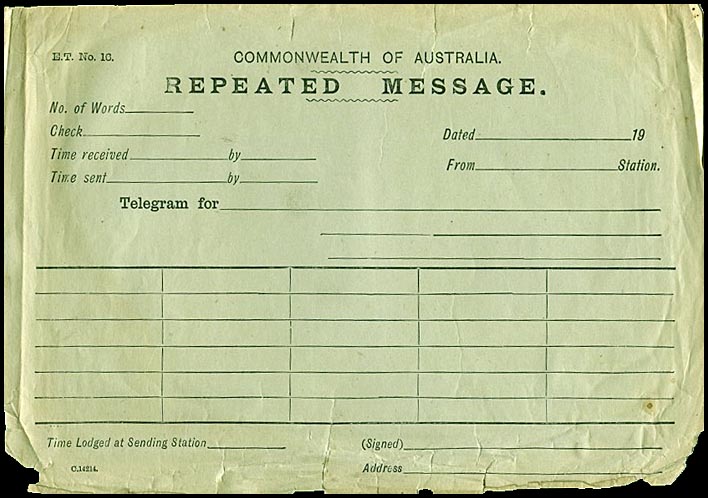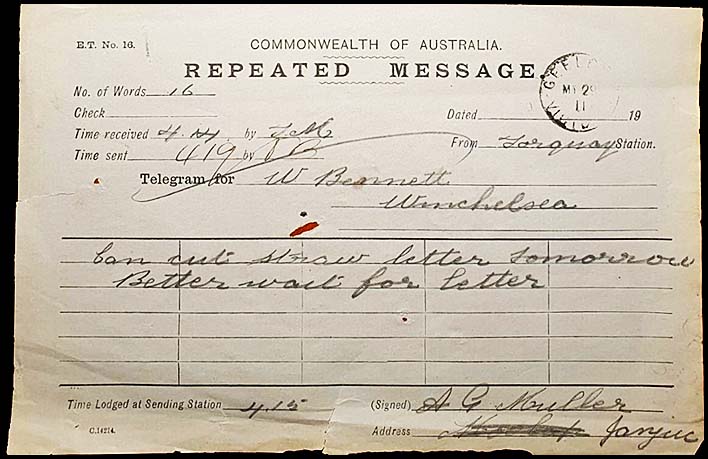Repeated message form: AB-TR-1.
- Home, index, site details
- Australia 1901-1988
-
New South Wales
- Overview of NSW
- Telegraph lines
- Telegraph Offices
- Date stamps
- Forms
- Envelopes
- Instructional annotation
- Collect
- Delayed
- Free
- Immediate Urgent
- Reply paid
- Rates
- Stamps
- 1871 Telegraph stamps
- 1885 proposal
- 1893 proposal
- Queensland
- South Australia
- Tasmania
- Victoria
- Western Australia
- International
- Special aspects
| Heading and notes: | Form E. T. No. 16. COMMONWEALTH OF AUSTRALIA above REPEATED TELEGRAM. |
| Message area: | 6 rows of 5 unnumbered boxes. |
| Reverse side: | Blank. |
| Colours (text & form): | Black on green. |
| Size of form overall: | 193 × 222 mm. |
| Size of datestamp area: | 28 × 46 mm. |
- Printed before 1929 because the ET Form numbers were discontinued in that year;
-
The date on the used form of 1911 would classify this form as being issued in the Interim Period.
Unlike all other forms of the same period, this Repeated Message form does not have a reference to the State.It may be therefore that this is the first telegram form to be marked AUSTRALIA only.
Details of Repeated Messages are summarised below as follows:
- concept of the facility;
- NSW regulations;
- post-Federation regulations;
- example of a Repeated Message form.
The intended meaning of the term "Repeated Telegram" was that it was possible to send a message and to have that message repeated back to the sender for confirmation that the original transmitted message was a true record of what had been intended.
Telegrams which could be used in legal or financial contexts are examples of telegrams where a check might be required on the accuracy of a message.
A sender of a message therefore would request at the Telegraph Office that a message being handed over for transmission should be a Repeated Message. Such a message was therefore completely different from:
- a message sent to the same person more than once;
- an identical message sent to many people at the same time (this was a multiple telegram);
- a message re-transmitted through a repeating station;
- the facility, introduced in 1913, that a person could have their telegram repeated to a different address for the payment of half the ordinary rate.
It is not known when the facility for Repeated Messages was introduced or withdrawn. Certainly it began in the Colonial days although possibly only in New South Wales.
In January 1895, the N.S.W. Electric Telegraph Act was amended as follows:
"Repeating Telegrams as Precautions against Mistakes, Delays, &c.
10. In order to provide against mistakes in the transmission and delivery of telegrams, every telegram of importance ought to be repeated by being signalled back from the receiving office to the transmitting office.
A copy of the message as repeated will be delivered to the sender. The charge for repetition is one-half of the ordinary tariff".
In July 1901, very soon after Federation, the following statement was issued in the Government Gazette:
Telegram and Postal Notice.
"The following amended regulation has been made by the Postmaster-General in accordance with the New South Wales Electrical Telegraphic Act: The Postmaster-General will not be responsible for any mistakes in, or delay, non-delivery or non-transmission of any unrepeated telegram, from whatever cause the same may arise. The Postmaster-General will not be responsible to any extent above £10 (ten pounds) for any mistakes in, or delay, non-delivery or non-transmission of any repeated telegram, from whatever cause the same may arise".
In August 1909, the Regulations were again slightly amended as follows:
"If the receiver of the telegram satisfies the department that the error or errors which actually occurred in the telegraph service render doubtful or unintelligible the whole of the words asked for in the request for repetition, the full amount paid for the request, and the reply, shall be refunded". The previous practice was that if the recipient of a telegram was doubtful about the correctness of certain words and therefore asked that the words be repeated, the cost of the whole message was charged to the customer. In the event of a departmental error being discovered, the customer would only receive a refund of the cost of the repeated words.
The 1922 Regulations on this type of message were as follows:
 |
The Repeated Message forms were printed in very limited numbers.
 Provenance: Dave Elsmore. |
AB-TR-1.
Unused Repeated Message form.
|
 Ebay (thammada111) , May 2023. |
AB-TR-1.
Used Repeated Message form for a message sent from Torquay to Winchlesea.. Characteristics:
The date of 1911 would classify this form as being issued in the Interim Period. Unlike all other forms of the same period, this Repeated Message form dow not have a reference to the State. It may be therefore that it the first telegram form to be marked AUSTRALIA only. |
Details of use and rarity.
| Form sub-number |
Schedule number | Earliest recorded date | Rarity rating |
| TR-1 | C.14214. | Geelong 29 May 1911. | RRRR (only one recorded) |